Multiple Choice
Identify the
choice that best completes the statement or answers the question.
|
|
|
1.
|
From whom did the United States purchase the
Louisiana territory?
a. | Cuba | b. | England | c. | France | d. | Spain |
|
|
|
2.
|
Who was the leader of the French government when
the United States purchased Louisiana?
a. | Jean Lafitte | b. | Louis XVI | c. | Napoleon
Bonaparte | d. | Toussaint
L’Ouverture |
|
|
|
3.
|
Which explains why France decided to sell Louisiana
to the United States?
a. | The French had no endearing ties to Louisiana and lost
interest. | b. | The new French government no longer wanted a colonial
empire. | c. | The colony of Louisiana did not support France during
the French Revolution. | d. | Napoleon’s
failure to control Saint-Domingue rendered Louisiana useless to the French
leader. |
|
|
|
4.
|
Who was president of the United States at the time
of the Louisiana Purchase?
a. | James Madison | b. | James Monroe | c. | John
Adams | d. | Thomas Jefferson |
|
|
|
5.
|
Which event led Thomas Jefferson to take steps that
resulted in the Louisiana Purchase?
a. | The War of 1812 weakened Spain’s resolve to
control North America. | b. | Spain repeatedly
closed the Mississippi River to U.S. shipping. | c. | France needed
money following the end of the French Revolution. | d. | Father Antonio Sedella was sent back to Spain, angering New Orleans
residents. |
|
|
|
Study the events list and then answer the question. 
|
|
|
6.
|
Which event occurred in 1803?
a. | Louisiana Purchase | b. | Battle of New Orleans | c. | Louisiana became a
state | d. | Father Antonio Sedella returned to
Spain |
|
|
|
7.
|
Which event occurred in 1812?
a. | Battle of New Orleans | b. | French Revolution began | c. | Louisiana became a
state | d. | War of 1812 began and
ended |
|
|
|
8.
|
Which event occurred in 1815?
a. | War of 1812 ended | b. | Battle of New Orleans | c. | Louisiana became a
state | d. | Slave Revolt in Saint-Domingue
|
|
|
|
Study the event list and then answer the question. 
|
|
|
9.
|
Which event returned control of Louisiana to
the French?
a. | War of 1812 | b. | Treaty of Ghent | c. | Pinckney’s
Treaty | d. | Treaty of San
Ildefonso |
|
|
|
10.
|
Which two events facilitated Napoleon
Bonaparte’s rise to power?
a. | War of 1812 and Treaty of
Ghent | b. | Pinckney’s Treaty and Treaty of San Ildefonso
| c. | France abolishes slavery and Louisiana
Purchase | d. | French Revolution and Saint-Domingue slave
revolt |
|
|
|
11.
|
Which event led to an increase in the domestic
slave trade?
a. | Pinckney’s Treaty | b. | France abolished slavery | c. | slave revolt in
Saint-Domingue | d. | importation of
slaves outlawed |
|
|
|
12.
|
Which provision of Pinckney’s Treaty was most
important to the United Sates’ economy in the late 1700s?
a. | boundary clarification | b. | return of Louisiana to France | c. | sale price of the Louisiana Territory | d. | access to the Mississippi River and New
Orleans |
|
|
|
13.
|
Territory Added to the United States
1787-1853
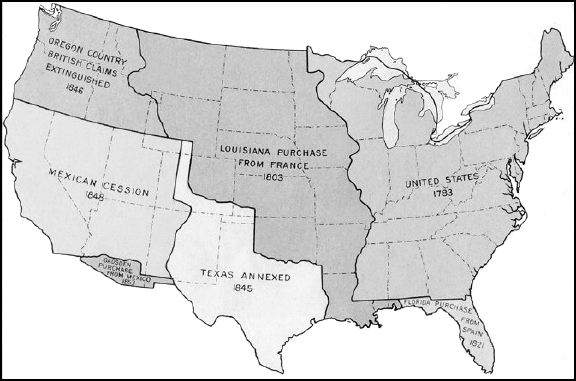 Based on the map, which
conclusion can be drawn about the impact of the Louisiana Purchase? Based on the map, which
conclusion can be drawn about the impact of the Louisiana Purchase?
a. | It divided the nation into three
regions. | b. | It more than doubled the size of the
country. | c. | It eliminated British claims in North
America. | d. | It separated the U.S. from all Spanish
claims. |
|
|
|
14.
|
Which is the correct sequence of transfers of
Louisiana to the United States?
a. | France to Spain then Spain to the United
States | b. | Spain to France then France to the United
States | c. | Spain to France then France to Pierre Clément de
Laussat | d. | France to Spain then Pierre Clément de Laussat to
the United States |
|
|
|
15.
|
Which explains Thomas Jefferson’s concern
about the Louisiana Purchase?
a. | The country would become too large too
fast. | b. | The natives on the land would have to be
relocated. | c. | He knew there was
no constitutional authority for purchasing land. | d. | He feared a Spanish attack along the country’s new western
border. |
|
|
|
16.
|
Which conclusion can be drawn about
Jefferson’s decision to proceed with the Louisiana purchase despite his concerns?
a. | He wanted to prevent a war with
France. | b. | He felt it was in the nation’s best
interest. | c. | He was trying to incite a conflict with
Spain. | d. | He valued the Constitution and the rule of
law. |
|
|
|
17.
|
Use the map to complete the next item. 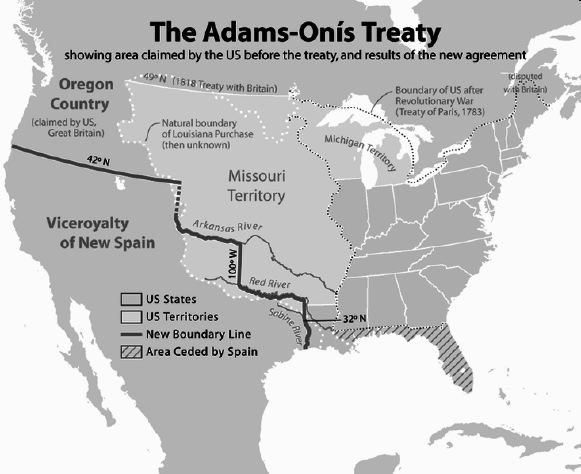 Based on the map, how did the Adams-Onís Treaty alter the United
States’ land claims? Based on the map, how did the Adams-Onís Treaty alter the United
States’ land claims?a. | The United States eliminated Spanish claims in North
America. | b. | The United States sold a large portion of the Louisiana
Purchase land to Missouri. | c. | The United States
gained control of Florida and defined its borders with Spanish claims. | d. | The United States ceded parts of the Louisiana Purchase to Spain in exchange
for control of Texas. |
|
|
|
18.
|
Why did many people disagree with Jefferson’s
choice for Louisiana’s first governor following the Louisiana Purchase?
a. | He had a history of
corruption. | b. | He had no
gubernatorial experience. | c. | He spoke openly
against Code Noir. | d. | He was unable to
communicate. |
|
|
|
19.
|
In Louisiana, what is a
parish?
a. | city | b. | county | c. | neighborhood | d. | town |
|
|
|
20.
|
In the early 1800s, which would be considered to be
filibustering?
a. | dueling | b. | bribing voters | c. | delaying
legislation | d. | unauthorized
exploration |
|
|
|
|
|
|
21.
|
Which would have best described the highlighted
area in 1810?
a. | West Florida | b. | East Louisiana | c. | South
Mississippi | d. | Mississippi
Floodplain |
|
|
|
22.
|
What two events led to United States control over
the highlighted region?
a. | War of 1812 and annexation | b. | revolt against Spain and annexation | c. | War of 1812 and the Louisiana Purchase | d. | Louisiana Purchase and revolt against
Spain |
|
|
|
23.
|
What is manumission?
a. | auctioning slaves | b. | masters setting slaves free | c. | allowing slaves to buy their freedom | d. | escaping on the Underground Railroad |
|
|
|
24.
|
How did Claiborne’s 1806 slave code differ
from previous colonial codes?
a. | allowed manumission | b. | allowed self-purchase | c. | outlawed
manumission | d. | outlawed
self-purchase |
|
|
|
25.
|
Claiborne’s acceptance of nine thousand
refugees from Haiti was in direct violation of which law?
a. | Code Noir | b. | 1806 slave code | c. | Treaty of San
Ildefonso | d. | 1804 ban on slave import to
Louisiana |
|
|
|
26.
|
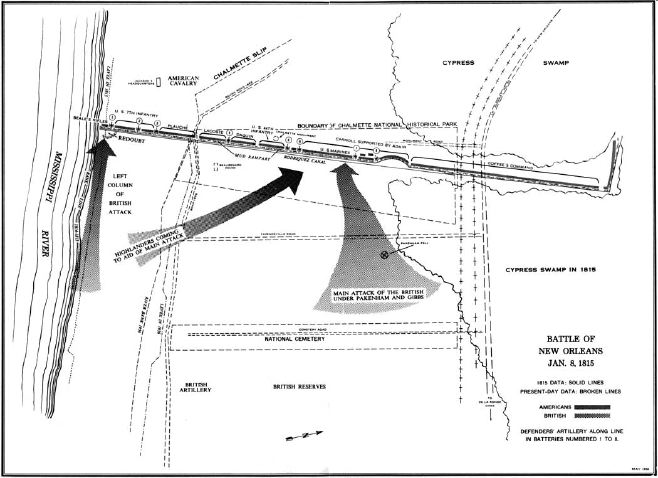 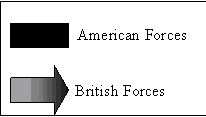 Which
conclusion can be drawn from the map? Which
conclusion can be drawn from the map?a. | The location of British forces gave them an
advantage. | b. | The Americans were
severely outnumbered by the British. | c. | The British were
not aware of the potential flooding hazard. | d. | The American
forces were greater in number than the British. |
|
|
|
27.
|
Which explains why British General Pakenham was
outraged when he arrived two weeks after his troops?
a. | They had forgotten to bring the
artillery. | b. | They were
outnumbered by the American troops. | c. | They had
concentrated all of their troops in one central location. | d. | Their position between the river and a swamp left them little room to
maneuver. |
|
|
|
28.
|
Use the map to answer the next question. 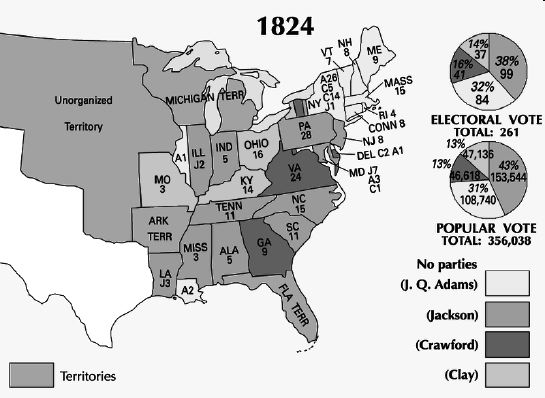 Which conclusion can be drawn from the 1824 presidential election
results? Which conclusion can be drawn from the 1824 presidential election
results?a. | Having four candidates split the electoral vote
preventing a clear winner. | b. | Andrew Jackson was
immediately named president of the United States. | c. | Andrew Jackson’s status as a war hero did not help him to win the
presidential election. | d. | Henry Clay was the
most likely candidate to win in a House of Representatives
decision. |
|
|
|
29.
|
Why did many people in Louisiana support Andrew
Jackson’s run for president?
a. | He was born in Louisiana. | b. | He kept a home in New Orleans. | c. | He visited New Orleans regularly. | d. | He protected them in the War of 1812. |
|
|
|
30.
|
What led Andrew Jackson to enlist the help of Jean
Lafitte prior to the Battle of New Orleans?
a. | He did not have any soldiers. | b. | His soldiers were poorly dressed. | c. | Lafitte’s men knew the area better than the
militia. | d. | His soldiers had inferior weapons and little
ammunition. |
|